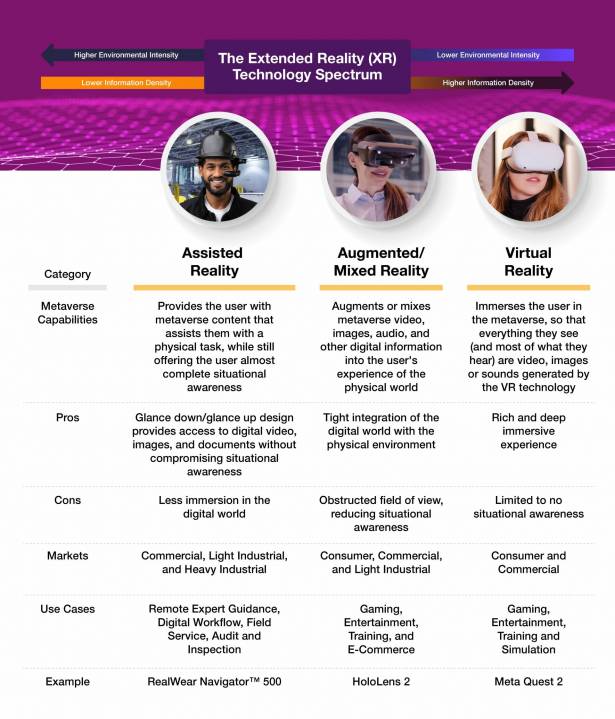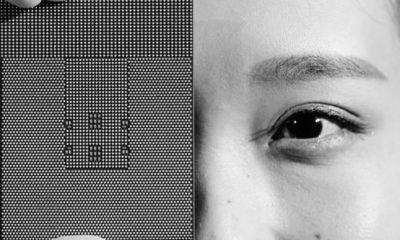Politics
The Extended Reality Spectrum Delivers a Variety of Metaverse Experiences
Published
2 years agoon
By
Drew Simpson
On its face, the term metaverse implies a single place. This might seem to mean that the metaverse has to be experienced by everyone in the same way. Yet the reality is that users can and should experience the metaverse in different ways.
And when one closely examines Extended Reality (XR), the core technology that most people use to access the metaverse, it quickly becomes apparent there are a spectrum of XR technologies, each of which delivers a different metaverse experience.
This XR spectrum includes:
- Virtual reality (VR), which attempts, as much as possible today, to plunge users into an all-digital, fully immersive metaverse experience.
- Augmented reality (AR) and mixed reality (MR) whereby the metaverse augments or is mixed with the user’s experience of physical reality.
- Assisted reality, whereby small, bite-sized amounts of digital content provide the user with an intentionally limited metaverse experience designed to assist them in the completion of real-world tasks without interfering with their situational awareness.
This spectrum of XR technologies allows digital transformation leaders to develop and deploy a wide variety of metaverse applications, and ensure that each one delivers its user – be they a CEO in an office, business line director in a meeting room, or frontline worker in the field – a metaverse experience that engages, empowers, and elevates them, without compromising workplace safety.
Information Density and Environmental Intensity
In examining which XR technology is best suited for a particular use case, two terms – information density and environmental intensity – can help those developing and deploying metaverse applications determine which XR technology will best allow them to achieve their business objectives.
Information density refers to the richness and detail of content delivered by an XR experience to the user. For example, VR technologies use binocular streaming of immersive video that fully occupies a user’s field of vision to deliver high information density. AR and MR technologies that mix digital content with a user’s view of their physical reality have a lower level of information density. Assisted reality technologies that allow users to see or glance at digital content while otherwise viewing all of their physical environment have an even lower level of information density.
XR technologies with high information densities provide users a more immersive experience, enabling these users to gain a fuller and more detailed understanding of complex digital data and other information. However, at the same time, XR technologies with high information densities demand higher levels of attention and information processing from the user than those with lower information densities. In fact, technologies at the very far end of the XR technology spectrum are so informationally dense that they can practically block out information from physical reality, greatly limiting the user’s situational awareness, which can compromise workplace safety.
Environmental intensity refers to the risk that the user’s physical environment:
- Could damage either the user or their XR device;
- Might require the user to operate their XR device for an extended period of time far from a power source; or
- Presents health and safety risks that require the user to wear certain types of personal protective equipment (PPE) or possess a certain ongoing level of situational awareness.
Examples of places with low environmental intensities include an office in a commercial building, a conference room in a hotel, or a trailer outside a construction site. Meanwhile, places with high environmental intensities include an operating room in a hospital, a garage in an automobile repair shop, the assembly line in a factory, an active construction site, or the top of a high voltage transmission tower or wind turbine.
As we examine the spectrum of XR technologies, we will generally see that metaverse use cases that require high information density are best used in locations with low environmental intensity. Meanwhile, metaverse use cases that take place in areas with high environmental intensity generally require technologies with a lower information density.
Virtual Reality — High Immersion, Low Situational Awareness
At one end of the XR technology spectrum lies VR, which delivers highly immersive metaverse experiences in which the user primarily sees and hears what is in the digital world. VR technologies, like the Oculus Quest (or the newer, rebranded Meta Quest 2), have high information densities that allow them to immerse the user in a virtual world, so that everything they see (and most of what they hear) are images or sounds generated by the VR technology. The ultimate virtual reality is exemplified in the Ready Player One movie, in which the users live their lives almost completely in a virtual world (until they are liberated from its all-consuming control).
Current technologies might not be able to mimic the virtual reality depicted on TV or movies, but they can provide us with visual and audio experiences that allow us to pretend we are a crane operator loading containers onto a ship, test-driving a new vehicle design , or virtually repairing a complex piece of industrial machinery.
VR’s high information density makes it ideal for gaming, entertainment, education, training, and simulation use cases in which any level of awareness of one’s actual physical environment lessens the value of the experience. However, at the same time the fully immersive experiences delivered by high information density VR technologies make them a poor choice for use cases where there is any environmental intensity at all. In fact, as those who have seen people using VR headsets know, tables, walls, and other objects that are usually safe can suddenly become a danger when someone loses most or all of their situational awareness in a virtual world.
This is the main reason why the use of VR in places with even moderate levels of environmental intensity – a city street, a bustling kitchen, a busy warehouse – is to be prohibited or aggressively avoided. Moreover, use cases in these places often involve the user wanting to augment or mix their physical reality experience with digital information, or just use digital information to assist them with a task. Yet in occupying most or all of the user’s cognitive load and information processing capabilities, VR leaves the user with little-to-no attention or information processing capabilities left to use with the physical world.
Augmented and Mixed Reality – Some Immersion, With Some Situation Awareness
In the middle of the XR technology spectrum lies AR and MR, in which the user augments or mixes their experience of the physical world with video, images, audio, and other digital information. AR and MR technologies, like Microsoft’s HoloLens 2, do not provide high enough information densities for a user to totally immerse themselves in the metaverse. Rather, they tightly integrate the metaverse with the physical world, delivering the user a hybrid physical and virtual experience.
There are many uses cases in which the integration of the physical world with the metaverse can be valuable – a gaming application that allows children to discover and interact with digital pets in their neighborhood, an entertainment application that shows a tourist in Rome what an ancient event in the Coliseum would have looked like from where they currently stand, a training application that overlays repair steps and tips on top of the physical object that the student is learning to fix, or an e-Commerce application that allows someone to see how new furniture would look in their home.
However, while AR and VR are well suited for gaming, entertainment, training, and e-Commerce use cases like these, there are still many use cases where high levels of environmental intensity demand that users have a full field of vision and a high level of situation awareness. Though they are less immersive than VR, the information density of AR and MR can still obscure aspects of one’s physical environment and draw attention away from environmental dangers. In addition, since AR and MR technologies generally cover most of the user’s field of vision, like VR technologies, it can be difficult to use them with hardhats, safety glasses, air purifiers, and the other types of PPE required in industrial and other places with high environmental intensities.
Assisted Reality – Low Immersion, with Full Situational Awareness
Assisted reality, a newer and less known XR technology, lies on the opposite end of the XR spectrum than VR. Unlike VR, assisted reality technologies, like my company’s RealWear Navigator 500, provide the user with nearly complete situational awareness, adding in digital content and experiences designed to only “assist” the user with their physical task. The user can consume information and collaborate with others through a digital metaverse experience, but these experiences are clearly separated from the user’s physical reality. One way to think of assisted reality is that it provides a small window into the metaverse that the user can quickly look or step away from whenever they need to.
Assisted reality is best suited for remote expert guidance, digital workflow, field service, audit and inspection, and other use cases where a reality-first, virtual-second experience is required. Examples of such use cases include a frontline-worker on a factory floor receiving guidance on how to repair a machine from a remote expert, a refinery worker calibrating a new measurement device with the device’s vendor, or a field-service technician using a workflow application to set up a new piece of equipment at a worksite.
Assisted reality technologies are typically appropriate for workers that must keep their field of vision free to prioritize situational awareness. This is typical of front-line workers across many industries who work alongside or with machines – from manufacturing systems on the plant floor, to material moving machines in the warehouse, to complex, dangerous systems located in the field like drilling equipment on an offshore oil platform.
For the frontline worker in industrial environments like these, the need for situational awareness translates directly into safety needs, where the introduction of an XR technology must never compromise safety. For industrial frontline workers maintaining and working with active machinery, safety is not just an imperative, it is a workplace culture that is often regulated and monitored by government agencies, and measured with KPIs that hold workers, managers, and company executives to account for safety violations.
Safety concerns like these mean that assisted reality must allow industrial frontline workers to keep both of their hands free and maintain situational awareness in places that are dirty, dangerous, and loud. As such, assisted reality solutions need to provide users with hands-free control of their metaverse experience, through voice command capabilities uniquely designed for high noise environments. In addition, with safety a baseline imperative, assisted reality technology must integrate seamlessly with PPE (especially hard hats with integrated hearing and eye protection). At the same time, these assisted reality solutions must be comfortable and powered to sustain all-shift usability.
A Spectrum of XR Technologies for Different Use Cases
The VR, AR, MR, and assisted reality technologies described above all vary greatly in form factor and where they lie on the XR technology spectrum. Yet, despite these differences, they are all being used today to connect workers to the metaverse in a range of markets and industries — from employee classrooms to factory shop floors, warehouses to offshore oil rigs. By finding the right balance of immersion, situational awareness, and other capabilities companies can use these XR technologies to offer their workers metaverse experiences that translate into increased efficiency, precision, and safety.
Rama Oruganti
Chief Product Officer at RealWear
Rama Oruganti is the Chief Product Officer at RealWear, where he is responsible for the product portfolio that includes hardware, software, and services.
You may like
-


The pain is real. The painkillers are virtual reality.
-


Huawei’s 5G chip breakthrough needs a reality check
-


Using Augmented Reality to Level up your E-Commerce Business
-


Mark Zuckerberg in the Metaverse: fantastic or frightening?
-


Enhancing UI/UX for Unforgettable Mobile Experiences
-


Capture Millennial and Gen Z Flexible Payments and Connected Shopping Experiences
Politics
Fintech Kennek raises $12.5M seed round to digitize lending
Published
7 months agoon
10/11/2023By
Drew Simpson
London-based fintech startup Kennek has raised $12.5 million in seed funding to expand its lending operating system.
According to an Oct. 10 tech.eu report, the round was led by HV Capital and included participation from Dutch Founders Fund, AlbionVC, FFVC, Plug & Play Ventures, and Syndicate One. Kennek offers software-as-a-service tools to help non-bank lenders streamline their operations using open banking, open finance, and payments.
The platform aims to automate time-consuming manual tasks and consolidate fragmented data to simplify lending. Xavier De Pauw, founder of Kennek said:
“Until kennek, lenders had to devote countless hours to menial operational tasks and deal with jumbled and hard-coded data – which makes every other part of lending a headache. As former lenders ourselves, we lived and breathed these frustrations, and built kennek to make them a thing of the past.”
The company said the latest funding round was oversubscribed and closed quickly despite the challenging fundraising environment. The new capital will be used to expand Kennek’s engineering team and strengthen its market position in the UK while exploring expansion into other European markets. Barbod Namini, Partner at lead investor HV Capital, commented on the investment:
“Kennek has developed an ambitious and genuinely unique proposition which we think can be the foundation of the entire alternative lending space. […] It is a complicated market and a solution that brings together all information and stakeholders onto a single platform is highly compelling for both lenders & the ecosystem as a whole.”
The fintech lending space has grown rapidly in recent years, but many lenders still rely on legacy systems and manual processes that limit efficiency and scalability. Kennek aims to leverage open banking and data integration to provide lenders with a more streamlined, automated lending experience.
The seed funding will allow the London-based startup to continue developing its platform and expanding its team to meet demand from non-bank lenders looking to digitize operations. Kennek’s focus on the UK and Europe also comes amid rising adoption of open banking and open finance in the regions.
Featured Image Credit: Photo from Kennek.io; Thank you!
Radek Zielinski
Radek Zielinski is an experienced technology and financial journalist with a passion for cybersecurity and futurology.
Politics
Fortune 500’s race for generative AI breakthroughs
Published
7 months agoon
10/11/2023By
Drew Simpson
As excitement around generative AI grows, Fortune 500 companies, including Goldman Sachs, are carefully examining the possible applications of this technology. A recent survey of U.S. executives indicated that 60% believe generative AI will substantially impact their businesses in the long term. However, they anticipate a one to two-year timeframe before implementing their initial solutions. This optimism stems from the potential of generative AI to revolutionize various aspects of businesses, from enhancing customer experiences to optimizing internal processes. In the short term, companies will likely focus on pilot projects and experimentation, gradually integrating generative AI into their operations as they witness its positive influence on efficiency and profitability.
Goldman Sachs’ Cautious Approach to Implementing Generative AI
In a recent interview, Goldman Sachs CIO Marco Argenti revealed that the firm has not yet implemented any generative AI use cases. Instead, the company focuses on experimentation and setting high standards before adopting the technology. Argenti recognized the desire for outcomes in areas like developer and operational efficiency but emphasized ensuring precision before putting experimental AI use cases into production.
According to Argenti, striking the right balance between driving innovation and maintaining accuracy is crucial for successfully integrating generative AI within the firm. Goldman Sachs intends to continue exploring this emerging technology’s potential benefits and applications while diligently assessing risks to ensure it meets the company’s stringent quality standards.
One possible application for Goldman Sachs is in software development, where the company has observed a 20-40% productivity increase during its trials. The goal is for 1,000 developers to utilize generative AI tools by year’s end. However, Argenti emphasized that a well-defined expectation of return on investment is necessary before fully integrating generative AI into production.
To achieve this, the company plans to implement a systematic and strategic approach to adopting generative AI, ensuring that it complements and enhances the skills of its developers. Additionally, Goldman Sachs intends to evaluate the long-term impact of generative AI on their software development processes and the overall quality of the applications being developed.
Goldman Sachs’ approach to AI implementation goes beyond merely executing models. The firm has created a platform encompassing technical, legal, and compliance assessments to filter out improper content and keep track of all interactions. This comprehensive system ensures seamless integration of artificial intelligence in operations while adhering to regulatory standards and maintaining client confidentiality. Moreover, the platform continuously improves and adapts its algorithms, allowing Goldman Sachs to stay at the forefront of technology and offer its clients the most efficient and secure services.
Featured Image Credit: Photo by Google DeepMind; Pexels; Thank you!
Deanna Ritchie
Managing Editor at ReadWrite
Deanna is the Managing Editor at ReadWrite. Previously she worked as the Editor in Chief for Startup Grind and has over 20+ years of experience in content management and content development.
Politics
UK seizes web3 opportunity simplifying crypto regulations
Published
7 months agoon
10/10/2023By
Drew Simpson
As Web3 companies increasingly consider leaving the United States due to regulatory ambiguity, the United Kingdom must simplify its cryptocurrency regulations to attract these businesses. The conservative think tank Policy Exchange recently released a report detailing ten suggestions for improving Web3 regulation in the country. Among the recommendations are reducing liability for token holders in decentralized autonomous organizations (DAOs) and encouraging the Financial Conduct Authority (FCA) to adopt alternative Know Your Customer (KYC) methodologies, such as digital identities and blockchain analytics tools. These suggestions aim to position the UK as a hub for Web3 innovation and attract blockchain-based businesses looking for a more conducive regulatory environment.
Streamlining Cryptocurrency Regulations for Innovation
To make it easier for emerging Web3 companies to navigate existing legal frameworks and contribute to the UK’s digital economy growth, the government must streamline cryptocurrency regulations and adopt forward-looking approaches. By making the regulatory landscape clear and straightforward, the UK can create an environment that fosters innovation, growth, and competitiveness in the global fintech industry.
The Policy Exchange report also recommends not weakening self-hosted wallets or treating proof-of-stake (PoS) services as financial services. This approach aims to protect the fundamental principles of decentralization and user autonomy while strongly emphasizing security and regulatory compliance. By doing so, the UK can nurture an environment that encourages innovation and the continued growth of blockchain technology.
Despite recent strict measures by UK authorities, such as His Majesty’s Treasury and the FCA, toward the digital assets sector, the proposed changes in the Policy Exchange report strive to make the UK a more attractive location for Web3 enterprises. By adopting these suggestions, the UK can demonstrate its commitment to fostering innovation in the rapidly evolving blockchain and cryptocurrency industries while ensuring a robust and transparent regulatory environment.
The ongoing uncertainty surrounding cryptocurrency regulations in various countries has prompted Web3 companies to explore alternative jurisdictions with more precise legal frameworks. As the United States grapples with regulatory ambiguity, the United Kingdom can position itself as a hub for Web3 innovation by simplifying and streamlining its cryptocurrency regulations.
Featured Image Credit: Photo by Jonathan Borba; Pexels; Thank you!
Deanna Ritchie
Managing Editor at ReadWrite
Deanna is the Managing Editor at ReadWrite. Previously she worked as the Editor in Chief for Startup Grind and has over 20+ years of experience in content management and content development.
